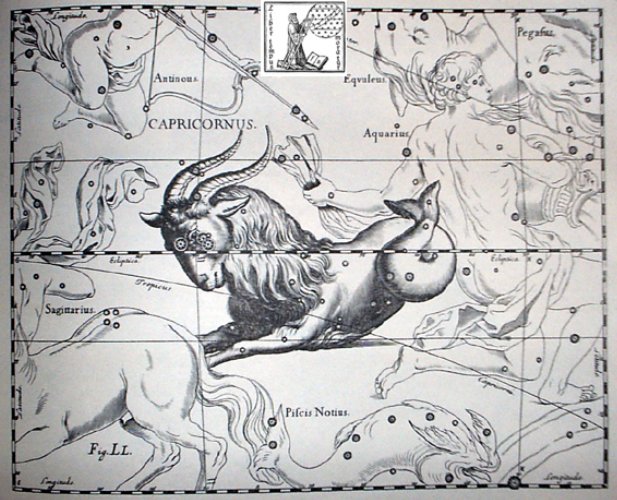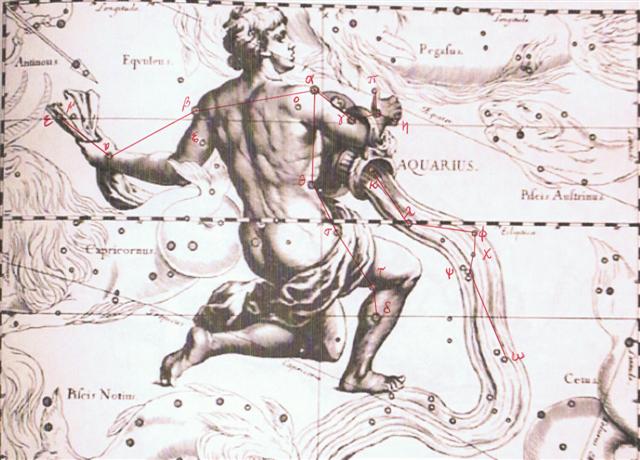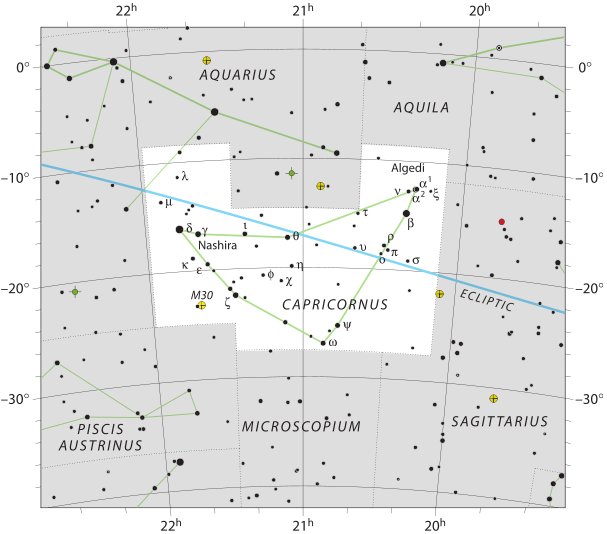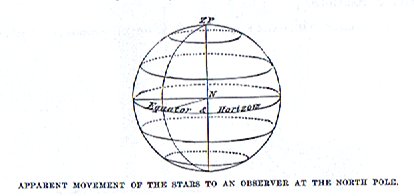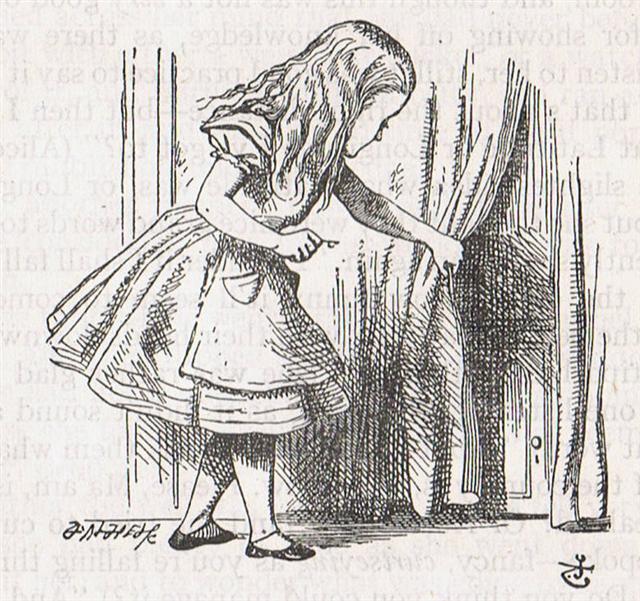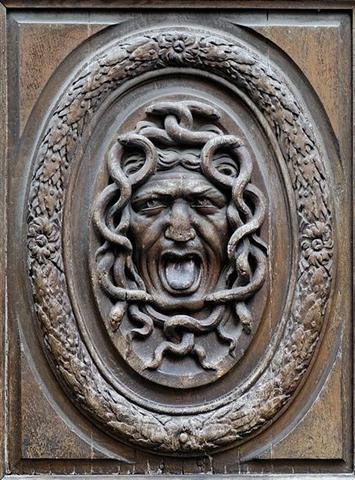The illustrations of Hevelius show us how the Goat-fish (Capricornus) and Aquarius were very close together, indeed touching each other, with a part of the fishy tail of Capricornus hiding the elbow of (cutting off the view of) the left arm of the Great One: ... Hevelius has demonstrated the dry part of Capricornus by placing a dry towel above in the left hand of Aquarius:
The stars forming Capricornus are spelling out a radical change between Algedi (the Goat, α) and Deneb Algiedi (the Tail of the Goat, δ):
However, in the Babylonian zodiac the figure corresponding to Aquarius (the Great One) is not close to the Goat-fish but quite a distance apart:
Possibly this distance should be thought of as 45 ( = 365 - 320) days. A change of around 45 right ascension days might have motivated the numbers 229 and 135, because 229 + 135 = 364 and 364 / 2 = 182 = 227 (→π) - 45 (= 135 - 90). ... Allen has documented all his star culminations at 21h, which should be due to an effort of keeping the culminations at their proper places according to the ancients, 24h (spring equinox) - 21h = 3h = 24h / 8 = 45º. 3h corresponds to 366 / 8 = 45.75 of my right ascension days and *366 - *46 = *320 (Dramasa, σ Octantis) ... Once upon a time there was a beam (a level beam for the spirits, a spirit-level) across between the equinoxes,
but since then this beam had been raised up from horizontal to vertical, to become a great Tree with a spinning top:
... Broken is your neck, oh Oto Uta, oh king! Floating (?) like a raft (?) out at sea. To be erected for the drifting huehue (fish) out at sea ... ka hati toou ngao e oto uta.e te ariki ē.mo tau papa rangaranga o haho i te tai.mo tuu huehue rangaranga o haho i te tai ... Ragaraga: 1. To float on the surface of the sea: miro ragaraga i ruga i te vai kava, driftwood floating on the sea. 2. To move ceaselessly (of people), to pace back and forth (te eve o te tagata); to be restless: e-ragaraga-nó-á te eve o te tagata, the man is nervous, worried, he paces back and forth. 3. E-ragaraga-nó-á te mana'u is said of inconstant, fickle people, who cannot concentrate on one thing: e-ragaraga-nó-á te mana'u o te ga poki; ta'e pahé tagata hônui, ku-noho-á te mana'u ki ruga ki te aga, children are fickle; they are not like serious adults who concentrate their work. Vanaga. The star chosen to remember 360 / 8 = 45 could have been the Demon Star (Algol, *45): .... Perseus lies next to his beloved Andromeda. Nearby are her parents Cepheus and Cassiopeia, as well as the monster, Cetus, to which she was sacrificed. Pegasus the winged horse completes the tableau. Perseus himself is shown holding the Gorgon’s head. The star that Ptolemy called ‘the bright one in the Gorgon head’ is Beta Persei, named Algol from the Arabic ra’s al-ghul meaning ‘the demon’s head’. (As an aside, al-ghul is also the origin of our word alcohol - quite literally ‘the demon drink’.) Algol is the type of star known as an eclipsing binary, consisting of two close stars that orbit each other, in this case every 2.9 days ... If there had been a contraction (since Babylonian times) with 45 days located after 21h (at the middle of Capricornus), then there ought to have been an extension at the other side of the sky roof.
Maybe this explains why the creators of Manuscript E have given us a sequence of dates to think about:
Page E:46 could then contain clues regarding such a shift in orientation. And surely, this page is beginning with a bird beating (with his wings) - his way of sounding like a drum (rutua te pahu) - and then there follows a reference which connects the mornings with the evenings - like the ancient (taketake) beam between the equinoxes: Take. The Marquesans are the only people who own to a distinctive national name, and retain a tradition of the road they travelled from their original habitat, until they arrived at the Marquesan Islands. They call themselves te Take, 'the Take nation'. Fornander. Take, Tuvaluan for the Black Noddy (Anous Minutes). The specific epithet taketake is Māori for long established, ancient, or original. In the Rapa Nui mythology, the deity Make-make was the chief god of the birdman cult, the other three gods associated with it being Hawa-tuu-take-take (the Chief of the eggs) his wife Vie Hoa and Vie Kanatea. Wikipedia.
... Curved Bay [hanga piko], the house where the bird beats (the rhythm), that is, where a certain chant is being recited, Ana Onoono (a cave well-suited as an overnight shelter), Pu Ngotangota (a coastal formation where seawater is allowed to flow in and out). 'Yours is the morning shadow' [ata popohanga toou] refers to an area in Ata Hero where the house of Ricardo Hero is now located. 'Yours is the evening shadow' [ata ahiahi toou] belongs to a 'turtle' [honu]. 'Apina Nui A Papa Nihoniho A Vere Nuanua A Papa O Rae' was the neck [te ngao] of the figure of Hinariru ... Tou. In ancient times, a tou was someone who had recovered from an epidemic, but whose illness meant that someone else in the family had to die. The tou were regarded as portents of evil. Toutou, lush; fertile (land). Toûa: Egg yolk; the colour yellow; soft, fibrous part of tree bark; toûa mahute, mahute fibres. Vanaga. Toua: Wrath, anger, rage, revenge, battle, combat, debate, dispute, dissension, uprising, revolt, quarrel, fight, hostility (taua); toua rae, to provoke, rae toua, to open hostilities, toua kakai, to rebuke, tuki toua, to stir up dissension; totoua, hostility; hakatoua, fighter, warrior. P Mgv.: toua, war, battle. Mq.: toua, war, dispute, quarrel. The form with o is found only in these three languages, taua is found in the general migration, Rapanui is the only speech which has both. Toutou, fertile (tautau); hakatoutou, to fertilize. Mq.: taútaú, fertile. Toùvae, to run; hakauruuru toùvae, id. Churchill.
|
|||||||||||||||||||||||||||||||||||||||||||||||||||||||||||||||||||||||||||||||||||||||||||||||||||||||||||||
